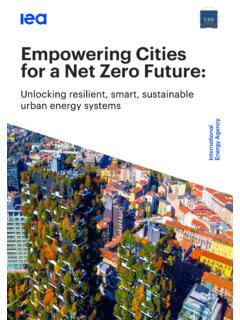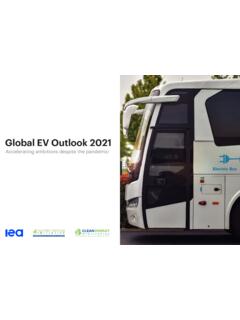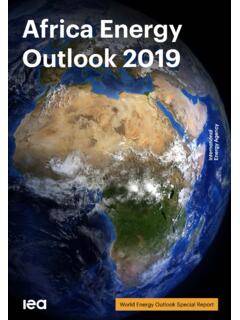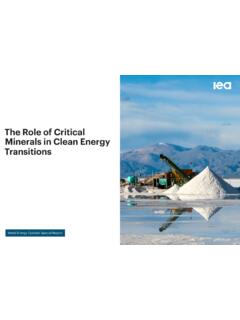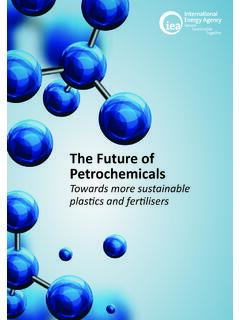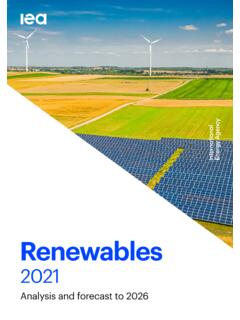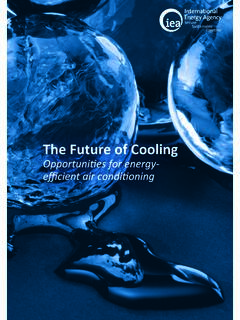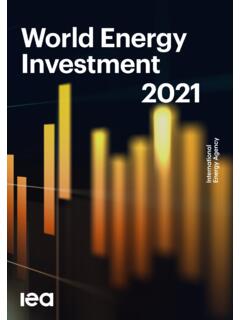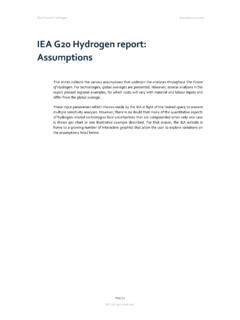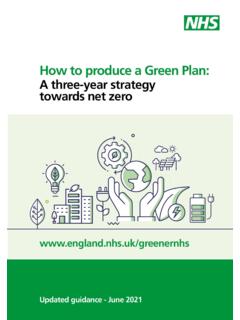Transcription of Net Zero by 2050
1 Net zero by 2050 A Roadmap for the Global EnergySectorNet zero by 2050 A Roadmap for theGlobal Energy SectorNet zero by 2050 zero by 2050 IEA member countries: Australia Austria BelgiumCanadaCzech Republic DenmarkEstoniaFinland France Germany Greece HungaryIreland ItalyJapanKorea Luxembourg Mexico Netherlands New Zealand NorwayPoland Portugal Slovak Republic Spain Sweden Switzerland Turkey United Kingdom United StatesThe European Commission also participates in the work of the IEAIEA association countries:BrazilChinaIndiaIndonesiaMoroc coSingaporeSouth AfricaThailandINTERNATIONAL ENERGYAGENCYThe IEA examines the full spectrum of energy issues including oil, gas and coal supply and demand, renewable energy technologies, electricity markets, energy efficiency, access to energy, demand side management and much more.
2 Through its work, the IEA advocates policies that will enhance the reliability, affordability and sustainability of energy in its 30 member countries, 8 association countries and note that this publication is subject to specific restrictions that limit its use and distribution. The terms and conditions are available online at publication and any map included herein are without prejudice to the status of or sovereignty over any territory, to the delimitation of international frontiers and boundaries and to the name of any territory, city or : IEA. All rights Energy Agency Website: version,July 2021 (3rd revision) Information noticefound at: 3 Foreword We are approaching a decisive moment for international efforts to tackle the climate crisis a great challenge of our times. The number of countries that have pledged to reach net zero emissions by mid century or soon after continues to grow, but so do global greenhouse gas emissions.
3 This gap between rhetoric and action needs to close if we are to have a fighting chance of reaching net zero by 2050 and limiting the rise in global temperatures to C. Doing so requires nothing short of a total transformation of the energy systems that underpin our economies. We are in a critical year at the start of a critical decade for these efforts. The 26th Conference of the Parties (COP26) of the United Nations Framework Convention on Climate Change in November is the focal point for strengthening global ambitions and action on climate by building on the foundations of the 2015 Paris Agreement. The International Energy Agency (IEA) has been working hard to support the UK government s COP26 Presidency to help make it the success the world needs. I was delighted to co host the IEA COP26 Net zero Summit with COP26 President Alok Sharma in March, where top energy and climate leaders from more than 40 countries highlighted the global momentum behind clean energy transitions.
4 The discussions at that event fed into this special report, notably through the Seven Key Principles for Implementing Net zero that the IEA presented at the Summit, which have been backed by 22 of our member governments to date. This report maps out how the global energy sector can reach net zero by 2050. I believe the report Net zero by 2050: A roadmap for the global energy system is one of the most important and challenging undertakings in the IEA s history. The Roadmap is the culmination of the IEA s pioneering work on energy data modelling, combining for the first time the complex models of our two flagship series, the World Energy Outlook and Energy Technology Perspectives. It will guide the IEA s work and will be an integral part of both those series going forward. Despite the current gap between rhetoric and reality on emissions, our Roadmap shows that there are still pathways to reach net zero by 2050.
5 The one on which we focus is in our analysis the most technically feasible, cost effective and socially acceptable. Even so, that pathway remains narrow and extremely challenging, requiring all stakeholders governments, businesses, investors and citizens to take action this year and every year after so that the goal does not slip out of reach. This report sets out clear milestones more than 400 in total, spanning all sectors and technologies for what needs to happen, and when, to transform the global economy from one dominated by fossil fuels into one powered predominantly by renewable energy like solar and wind. Our pathway requires vast amounts of investment, innovation, skilful policy design and implementation, technology deployment, infrastructure building, international co operation and efforts across many other areas.
6 Since the IEA s founding in 1974, one of its core missions has been to promote secure and affordable energy supplies to foster economic growth. This has remained a key concern of our Roadmap, drawing on special analysis carried out with the International Monetary Fund and the International Institute for Applied Systems Analysis. It shows that the enormous IEA. All rights reserved. 4 International Energy Agency | Special Report challenge of transforming our energy systems is also a huge opportunity for our economies, with the potential to create millions of new jobs and boost economic growth. Another guiding principle of the Roadmap is that clean energy transitions must be fair and inclusive, leaving nobody behind. We have to ensure that developing economies receive the financing and technological know how they need to continue building their energy systems to meet the needs of their expanding populations and economies in a sustainable way.
7 It is a moral imperative to bring electricity to the hundreds of millions of people who currently are deprived of access to it, the majority in of them in Africa. The transition to net zero is for and about people. It is paramount to remain aware that not every worker in the fossil fuel industry can ease into a clean energy job, so governments need to promote training and devote resources to facilitating new opportunities. Citizens must be active participants in the entire process, making them feel part of the transition and not simply subject to it. These themes are among those being explored by the Global Commission on People Centred Clean Energy Transitions, which I convened at the start of 2021 to examine how to enable citizens to benefit from the opportunities and navigate the disruptions of the shift to a clean energy economy.
8 Headed by Prime Minister Mette Frederiksen of Denmark and composed of government leaders, ministers and prominent thinkers, the Global Commission will make public its key recommendations ahead of COP26 in November. The pathway laid out in our Roadmap is global in scope, but each country will need to design its own strategy, taking into account its specific circumstances. There is no one size fits all approach to clean energy transitions. Plans need to reflect countries differing stages of economic development: in our pathway, advanced economies reach net zero before developing economies do. As the world s leading energy authority, the IEA stands ready to provide governments with support and advice as they design and implement their own roadmaps, and to encourage the international co operation across sectors that is so essential to reaching net zero by 2050.
9 This landmark report would not have been possible without the extraordinary dedication of the IEA colleagues who have worked so tirelessly and rigorously on it. I would like to thank the entire team under the outstanding leadership of my colleagues Laura Cozzi and Timur G l. The world has a huge challenge ahead of it to move net zero by 2050 from a narrow possibility to a practical reality. Global carbon dioxide emissions are already rebounding sharply as economies recover from last year s pandemic induced shock. It is past time for governments to act, and act decisively to accelerate the clean energy transformation. As this report shows, we at the IEA are fully committed to leading those efforts. Dr Fatih Birol Executive Director International Energy Agency Acknowledgements 5 Acknowledgements This study, a cross agency effort, was prepared by the World Energy Outlook team and the Energy Technology Perspectives team.
10 The study was designed and directed by Laura Cozzi, Chief Energy Modeller and Head of Division for Energy Demand Outlook, and Timur G l, Head of Division for Energy Technology Policy. The lead authors and co ordinators were: St phanie Bouckaert, Araceli Fernandez Pales, Christophe McGlade, Uwe Remme and Brent Wanner. Laszlo Varro, Chief Economist, Davide D Ambrosio and Thomas Spencer were also part of the core team. The other main authors were: Thibaut Abergel (buildings), Yasmine Arsalane (economic outlook, electricity), Praveen Bains (biofuels), Jose Miguel Bermudez Menendez (hydrogen), Elizabeth Connelly (transport), Daniel Crow (behaviour), Amrita Dasgupta (innovation), Chiara Delmastro (buildings), Timothy Goodson (buildings, bioenergy), Alexandre Gouy (industry), Paul Hugues (industry), Lilly Lee (transport), Peter Levi (industry), Hana Mandova (industry), Ariane Millot (buildings), Pawe Olejarnik (fossil fuel supply), Leonardo Paoli (innovation, transport), Faidon Papadimoulis (data management), Sebastian Papapanagiotou (electricity networks), Francesco Pavan (hydrogen), Apostolos Petropoulos (transport), Ryszard Po piech (data management), Leonie Staas (behaviour, industry), Jacopo Tattini (transport)
